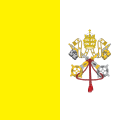History of Christian flags

The history of Christian flags encompasses the establishment of
National flags with Christian symbolism

Christian empires, such as the Kingdom of Georgia, which became a Christian state in AD 337, adopted Christian symbolism in its flag.[2] Likewise, the flags of the Byzantine Empire often depicted "a bowl with a cross, symbol[ic] of the Byzantine worldly domination for centuries and of the ecumenical mission to spread Christianity to all the world".[3]
Many officially Christian states and predominantly Christian countries have flags with
Crusader era
In the
-
Flag of the French crusaders and the Order of Saint George
-
Flag of the English crusaders
-
Flag of the Italian crusaders
-
Flag of the Flemish crusaders
-
Flag of the Breton crusaders
-
Flag of the Gascon crusaders
-
Flag of the German crusaders, then used as the war flag of the Holy Roman Empire
-
Flag of the Danish crusaders
-
Flag of the crusader army of György Dózsa
-
Flag of the Knights Hospitaller (Sovereign Military Order of Malta)
-
Variant flag of the Knights Hospitaller (Sovereign Military Order of Malta)
-
Flag of the Knights Templar
-
Flag of the Teutonic Order
-
Flag of the Order of Saint Lazarus
-
Flag of the Order of the Holy Sepulchre
-
Flag of the Kingdom of Jerusalem
-
Flag of Marseille also has its origins in the Crusader era
-
Flag of the Kingdom of Cyprus
-
Flag of the Galleys of the Order of Saint Stephen
-
Flag of the County of Tripoli
Flags of Christian denominations
Many Christian denominations have their own denominational flag and display it alongside the ecumenical Christian Flag or independent from it.[5]
The
Parishes in the
The
The
The
The
The
The
The
Additionally, many Catholic, Protestant and Orthodox churches maintain the use of the Labarum, a historical symbol of Christianity, which is rarely used as a flag at present.
-
Flag of TheRoman Catholic Church, also the flag of Vatican City and The Holy See
-
Flag of the Greek Orthodox Church
-
Flag of the Georgian Orthodox Church
-
Flag of the Episcopal Church
-
Flag of the Serbian Orthodox Church
-
Flag of the Armenian Apostolic Church
-
Standard of The Salvation Army
-
Flag of the Church of Scotland
-
Flag of the Church of Ireland
-
Flag of Anglican Church of Australia
-
Flag of the Anglican Church of Canada
-
Flag of the Protestant Church in Germany
-
Flag of the Protestant Church in Germany (alternative version)
-
Flag of the Church of Sweden
-
Flag of the Hussites
Christian Flag adopted by the Federal Council of Churches

In the beginnings of ecumenical movement in the late 19th and early 20th centuries,
The ground is white, representing peace, purity and innocence. In the upper corner is a blue square, the color of the unclouded sky, emblematic of heaven, the home of the Christian; also a symbol of faith and trust. in the center of the blue is the cross, the ensign and chosen symbol of Christianity: the cross is red, typical of Christ's blood.[7]
The
The famous
See also
- Labarum
- Islamic flags
References
- ^ a b Lovette, Leland Pearson (1934). Naval Customs, Traditions and Usage. United States naval institute. p. 152.
- ISBN 9781490736082.
- ISBN 9781440117534.
- ^ ISBN 9789673052943.
The medieval Christian flags with different kinds of crosses (Latin, Templars, St. John's or arrow-head cross', St. Andrew's or saltire, 'nailed", etc.) linked the knights with the church. It was a religious symbol of Christian 'holy wars' or crusades which invigorated and united the enemies of Islam.
- ^ Christian Flag Facts, Montney.
- ISBN 9781405153768.
- ^ The Christian Advocate. 84. New York: T. Carlton & J. Porter. 7 January 1909.
Within recent years (1897) a flag has been designed which shall stand as an emblem; (Jesse L. Jones-McKay) which all Christian nations and various denominations may rally in allegiance and devotion. This banner is called the Christian flag. It was originated by Charles C. Overton of Brooklyn, N.Y., whose first thought of it came to him while addressing a Sunday school at a rally day service. The flag is most symbolic. The ground is white, representing peace, purity and innocence. In the upper corner is a blue square, the color of the unclouded sky, emblematic of heave, the home of the Christian; also a symbol of faith and trust. in the center of the blue is the cross, the ensign and chosen symbol of Christianity: the cross is red, typical of Christ's blood. The use of the national flag in Christian churches has become almost universal throughout the world.
- ^ Coffman, Elesha. "Do you know the history of the Christian flag?". Christianity Today. Retrieved 24 April 2014.
- The Christian Advocate. 84. New York: T. Carlton & J. Porter. 7 January 1909.
Mr. Overton has dedicated his flag to the Christian world, refusing to copyright or patent it. It stands for no creed or denomination, but for Christianity. Every sect of Christ's followers can indorse this flag and it is equally appropriate for all nations. The hymn written by Fanny Crosby is also dedicated to the free use and followers of Christ the world over.
- ^ a b "Resolution". Federal Council Bulletin. 25–27. Religious Publicity Service of the Federal Council of the Churches of Christ in America. 1942.
- ^ Baptistry. Episcopal Diocese of Fort Worth: Saint John’s Episcopal Church. Retrieved 23 September 2021.
The Christian flag indicates that through baptism man shares in this divine victory over evil and eternal death.
- ^ Kelland, Ariana; Howells, Laura (March 23, 2016). "Controversial Christian flag removed as provincial, national flags flown at half-mast". CBC News. Retrieved January 2, 2020.
Rev. Howard Hynes is the pastor at St. Stephen the Martyr Anglican Network Church, which organized the flag raisings.
- ^ Grose, Howard Benjamin (1917). Missions: American Baptist International Magazine. American Baptist Convention. p. 49.
Side by side in many of our churches hangs the Christian Flag with the Stars and Stripes—the Flag of White— which forever has stood for peace, having in the corner on the field of blue, the color of sincerity, faith and truth, the red Cross symbolic of Calvary.
- ^ Flick, Stephen (24 September 2020). "Why We Fly the Christian Flag". Christian Heritage Fellowship. Retrieved 23 September 2021.
- Greeley: First Congregational Church. Retrieved 23 September 2021.
On the other side of the sanctuary is a Christian flag.
- ^ "WELS Flag Presentation" (PDF). Wisconsin Evangelical Lutheran Synod. Retrieved 23 September 2021.
- ISBN 9780836131062.
Most congregations of Russian Mennonite heritage displayed both the national and the Christian flag in the church sanctuary.
- ^ Trewhitt, Katharine L. (1984). History of Broad Street United Methodist Church, Cleveland, Tennessee, 1836-1984: The Story of Methodism in Bradley County and of the Group which Became Broad Street United Methodist Church. The Church. p. 129. Retrieved 8 July 2017.
In 1968 the Methodist Men of Broad Street purchased flags to be used in the sanctuary of the Church. This involved one United States flag, one Christian flag, flag poles, stands, one eagle and one cross.
- ^ Aalberts, Leon (2021). "Flags in the Sanctuary" (PDF). Williamstown: First Congregational Church. p. 5. Retrieved 23 September 2021.
Since its adoption by the United States Federal Council of Churches in 1942, it has been used by many Christian traditions, including the Anglican, Baptist, Lutheran, Mennonite, Methodist, Moravian, Presbyterian, Quaker, and Reformed, among others.
- ^ Achtemeier, Katherine (1 July 2016). "Flags in worship". The Presbyterian Outlook. Retrieved 23 September 2021.
For as long as anyone could remember, the American flag had been displayed in the front of the sanctuary to the congregation's left — to their right, the Christian flag.
- ISBN 9780913342220. Retrieved 8 July 2017.
- ISBN 9780802819437.
- ^ The Quiver. Cassell Limited. 1900. p. 380. Retrieved 4 May 2014.
Miss Fanny J. Crosby, the veteran American hymn writer, has dedicated a hymn, called "The Christian Flag," to the movement, the first verse of which is :— " The Christian Flag!
- ^ James R. Pollock, Ph.D., D.D. (23 March 1996). Congratulations to The Christian Flag (Fourth ed.).
{{cite book}}: CS1 maint: multiple names: authors list (link)





































































